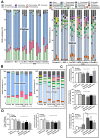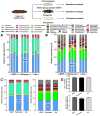More Prominent Inflammatory Response to Pachyman than to Whole-Glucan Particle and Oat-β-Glucans in Dextran Sulfate-Induced Mucositis Mice and Mouse Injection through Proinflammatory Macrophages
- PMID: 35409384
- PMCID: PMC8999416
- DOI: 10.3390/ijms23074026
More Prominent Inflammatory Response to Pachyman than to Whole-Glucan Particle and Oat-β-Glucans in Dextran Sulfate-Induced Mucositis Mice and Mouse Injection through Proinflammatory Macrophages
Abstract
(1→3)-β-D-glucans (BG) (the glucose polymers) are recognized as pathogen motifs, and different forms of BGs are reported to have various effects. Here, different BGs, including Pachyman (BG with very few (1→6)-linkages), whole-glucan particles (BG with many (1→6)-glycosidic bonds), and Oat-BG (BG with (1→4)-linkages), were tested. In comparison with dextran sulfate solution (DSS) alone in mice, DSS with each of these BGs did not alter the weight loss, stool consistency, colon injury (histology and cytokines), endotoxemia, serum BG, and fecal microbiome but Pachyman-DSS-treated mice demonstrated the highest serum cytokine elicitation (TNF-α and IL-6). Likewise, a tail vein injection of Pachyman together with intraperitoneal lipopolysaccharide (LPS) induced the highest levels of these cytokines at 3 h post-injection than LPS alone or LPS with other BGs. With bone marrow-derived macrophages, BG induced only TNF-α (most prominent with Pachyman), while LPS with BG additively increased several cytokines (TNF-α, IL-6, and IL-10); inflammatory genes (iNOS, IL-1β, Syk, and NF-κB); and cell energy alterations (extracellular flux analysis). In conclusion, Pachyman induced the highest LPS proinflammatory synergistic effect on macrophages, followed by WGP, possibly through Syk-associated interactions between the Dectin-1 and TLR-4 signal transduction pathways. Selection of the proper form of BGs for specific clinical conditions might be beneficial.
Keywords: DSS-induced mucositis; extracellular flux; mice; microbiome; proinflammatory macrophages; β-glucans.
Conflict of interest statement
The authors declare no conflict of interest.
Figures









Similar articles
-
Candida Administration in 5/6 Nephrectomized Mice Enhanced Fibrosis in Internal Organs: An Impact of Lipopolysaccharide and (1→3)-β-D-Glucan from Leaky Gut.Int J Mol Sci. 2022 Dec 15;23(24):15987. doi: 10.3390/ijms232415987. Int J Mol Sci. 2022. PMID: 36555628 Free PMC article.
-
Uremia-Induced Gut Barrier Defect in 5/6 Nephrectomized Mice Is Worsened by Candida Administration through a Synergy of Uremic Toxin, Lipopolysaccharide, and (1➔3)-β-D-Glucan, but Is Attenuated by Lacticaseibacillus rhamnosus L34.Int J Mol Sci. 2022 Feb 24;23(5):2511. doi: 10.3390/ijms23052511. Int J Mol Sci. 2022. PMID: 35269654 Free PMC article.
-
Enhanced Bacteremia in Dextran Sulfate-Induced Colitis in Splenectomy Mice Correlates with Gut Dysbiosis and LPS Tolerance.Int J Mol Sci. 2022 Jan 31;23(3):1676. doi: 10.3390/ijms23031676. Int J Mol Sci. 2022. PMID: 35163596 Free PMC article.
-
A (1→6)-Branched (1→4)-β-d-Glucan from Grifola frondosa Inhibits Lipopolysaccharide-Induced Cytokine Production in RAW264.7 Macrophages by Binding to TLR2 Rather than Dectin-1 or CR3 Receptors.J Nat Prod. 2020 Feb 28;83(2):231-242. doi: 10.1021/acs.jnatprod.9b00584. Epub 2020 Jan 22. J Nat Prod. 2020. PMID: 31967822
-
Blood Bacteria-Free DNA in Septic Mice Enhances LPS-Induced Inflammation in Mice through Macrophage Response.Int J Mol Sci. 2022 Feb 8;23(3):1907. doi: 10.3390/ijms23031907. Int J Mol Sci. 2022. PMID: 35163830 Free PMC article.
Cited by
-
Lipopolysaccharide Tolerance Enhances Murine Norovirus Reactivation: An Impact of Macrophages Mainly Evaluated by Proteomic Analysis.Int J Mol Sci. 2023 Jan 17;24(3):1829. doi: 10.3390/ijms24031829. Int J Mol Sci. 2023. PMID: 36768154 Free PMC article.
-
Presence of Pseudomonas aeruginosa in feces exacerbate leaky gut in mice with low dose dextran sulfate solution, impacts of specific bacteria.PLoS One. 2024 Nov 15;19(11):e0309106. doi: 10.1371/journal.pone.0309106. eCollection 2024. PLoS One. 2024. PMID: 39546435 Free PMC article.
-
The Regulatory Roles of Ezh2 in Response to Lipopolysaccharide (LPS) in Macrophages and Mice with Conditional Ezh2 Deletion with LysM-Cre System.Int J Mol Sci. 2023 Mar 10;24(6):5363. doi: 10.3390/ijms24065363. Int J Mol Sci. 2023. PMID: 36982437 Free PMC article.
-
Less Severe Sepsis in Cecal Ligation and Puncture Models with and without Lipopolysaccharide in Mice with Conditional Ezh2-Deleted Macrophages (LysM-Cre System).Int J Mol Sci. 2023 May 10;24(10):8517. doi: 10.3390/ijms24108517. Int J Mol Sci. 2023. PMID: 37239864 Free PMC article.
-
Less Severe Lipopolysaccharide-Induced Inflammation in Conditional mgmt-Deleted Mice with LysM-Cre System: The Loss of DNA Repair in Macrophages.Int J Mol Sci. 2023 Jun 14;24(12):10139. doi: 10.3390/ijms241210139. Int J Mol Sci. 2023. PMID: 37373287 Free PMC article.
References
-
- Chaiyasut C., Pengkumsri N., Sivamaruthi B., Sirilun S., Kesika P., Saelee M., Chaiyasut K., Peerajan S. Extraction of Β-glucan of Hericium erinaceus, Avena sativa, L., and Saccharomyces cerevisiae and in vivo evaluation of their immunomodulatory effects. Food Sci. Technol. 2018;38:138–146. doi: 10.1590/fst.18217. - DOI
MeSH terms
Substances
Grants and funding
LinkOut - more resources
Full Text Sources
Miscellaneous

